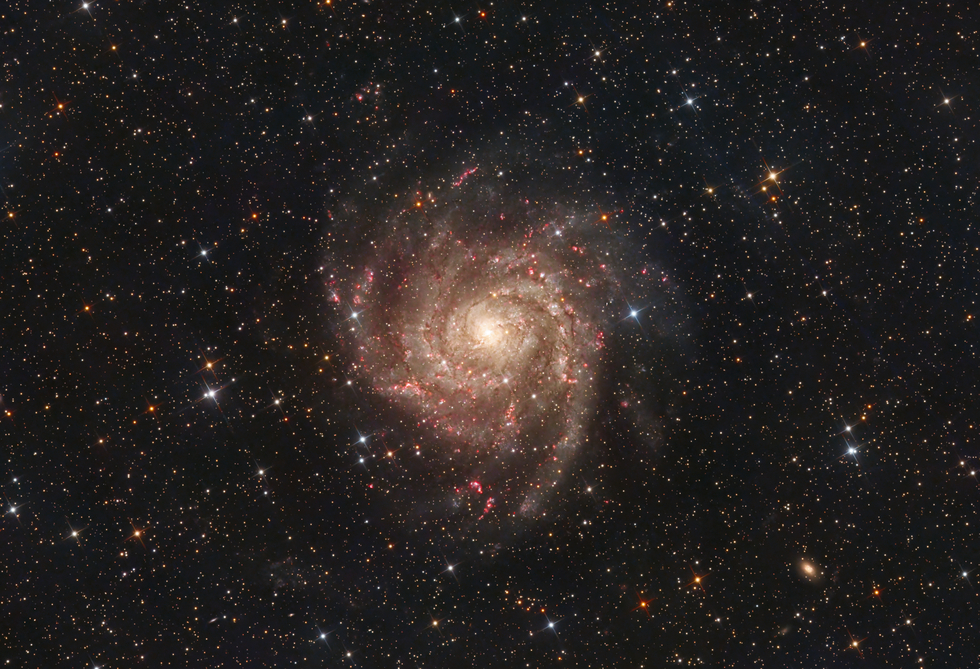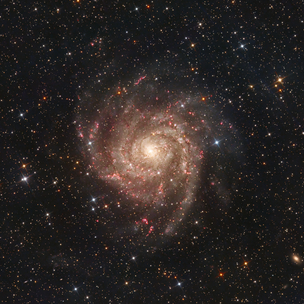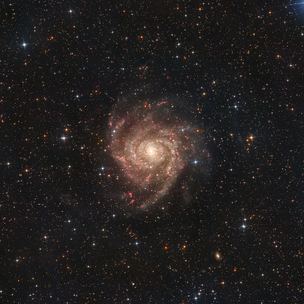The Hidden Galaxy - IC342
2
11
The Hidden Galaxy - IC342
The position of IC342 behind the galactic equator with a lot of dust from the Milky Way means that mainly red light is visible and gives the galaxy a reddish appearance (extinction).
IC 342 (also known as Caldwell 5) is an intermediate spiral galaxy in the constellation Camelopardalis, located relatively close to the Milky Way. Despite its size and actual brightness, its location behind dusty areas near the galactic equator makes it difficult to observe, leading to the nickname "The Hidden Galaxy". If the galaxy were not obscured, it would be visible by naked eye. The dust makes it difficult to determine its precise distance; modern estimates range from about 7 million light-years to about 11 Mly. The galaxy was discovered by William Frederick Denning in 1892. It is one of the brightest in the IC 342/Maffei Group, one of the closest galaxy groups to the Local Group. Edwin Hubble first thought it to be in the Local Group, but it was later determined not to be a member.
In 1935, Harlow Shapley found that it was wider than the full moon, and by angular size the third-largest spiral galaxy then known, smaller only than the Andromeda Galaxy (M31) and the Triangulum Galaxy (M33). Modern estimates are more conservative, giving the apparent size as one-half to two-thirds the diameter of the full moon).
It has an H II nucleus. The galaxy has a diameter of 75,000 light-years. In 2020, the galaxy KKH 32 was identified as the first known satellite of IC 342 that is a dwarf spheroidal galaxy. Unlike galaxies with large bulges such as the Andromeda Galaxy, IC 342 has relatively few dwarf satellite galaxies. KKH 32 is located about 10.2 million light-years (3.12 megaparsecs) away, and has a diameter of about 4,300 light-years (credit: Wikipedia)
IC 342 (also known as Caldwell 5) is an intermediate spiral galaxy in the constellation Camelopardalis, located relatively close to the Milky Way. Despite its size and actual brightness, its location behind dusty areas near the galactic equator makes it difficult to observe, leading to the nickname "The Hidden Galaxy". If the galaxy were not obscured, it would be visible by naked eye. The dust makes it difficult to determine its precise distance; modern estimates range from about 7 million light-years to about 11 Mly. The galaxy was discovered by William Frederick Denning in 1892. It is one of the brightest in the IC 342/Maffei Group, one of the closest galaxy groups to the Local Group. Edwin Hubble first thought it to be in the Local Group, but it was later determined not to be a member.
In 1935, Harlow Shapley found that it was wider than the full moon, and by angular size the third-largest spiral galaxy then known, smaller only than the Andromeda Galaxy (M31) and the Triangulum Galaxy (M33). Modern estimates are more conservative, giving the apparent size as one-half to two-thirds the diameter of the full moon).
It has an H II nucleus. The galaxy has a diameter of 75,000 light-years. In 2020, the galaxy KKH 32 was identified as the first known satellite of IC 342 that is a dwarf spheroidal galaxy. Unlike galaxies with large bulges such as the Andromeda Galaxy, IC 342 has relatively few dwarf satellite galaxies. KKH 32 is located about 10.2 million light-years (3.12 megaparsecs) away, and has a diameter of about 4,300 light-years (credit: Wikipedia)
SPECIFICATIONS
Telescope
8'' f5 Newton
Camera
Touptek ATR2600M
Location
Hamburg, Germany
Date of observation
November 29th - Dec 1st
Filters
LRGBHa
Processing
PixInsight / PS
Credits
Rouven Asmussen
Comments
Excellent write-up, and great colors!
Many thanks, Judith! But to be honest most of the text is from Wikipedia :)






